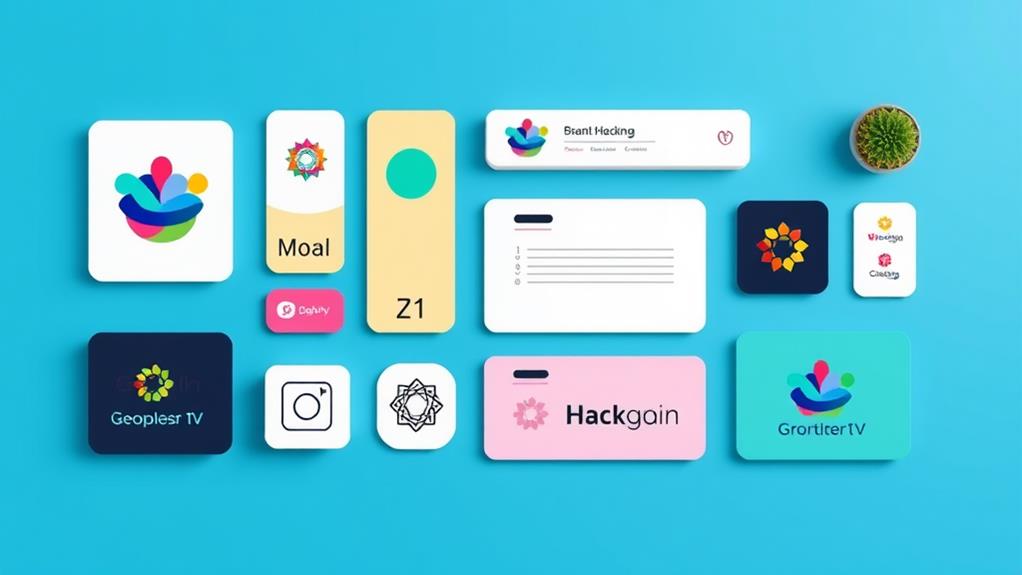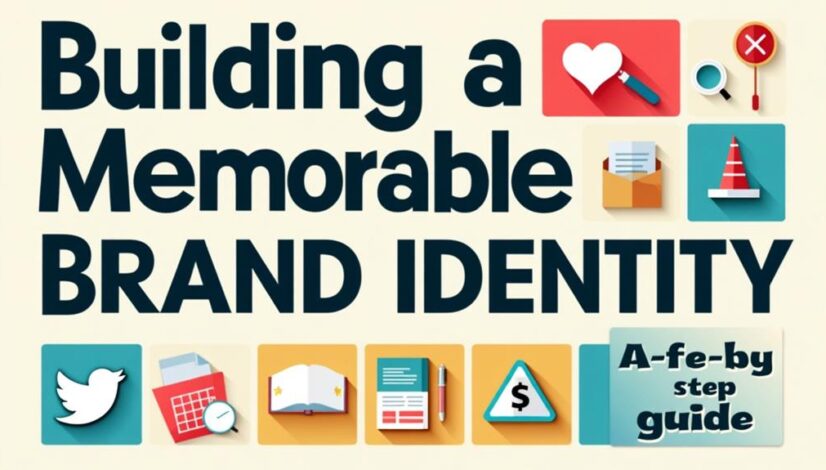Building a Memorable Brand Identity: A Step-by-Step Guide
Building a memorable brand identity involves a strategic approach that starts with understanding your target audience and defining your brand mission. Next, craft a unique value proposition that differentiates your business. Develop a brand personality that resonates emotionally, followed by creating a cohesive visual identity, including a distinctive logo. Establish a consistent brand voice and guarantee uniform messaging across all platforms. Finally, monitor your brand's performance and adapt as necessary to remain relevant. This systematic framework not only strengthens recognition but also fosters customer loyalty, paving the way for deeper insights into effective branding strategies.
Key Takeaways
- Understand your target audience through demographic analysis and emotional connections to tailor your brand messaging effectively.
- Define your brand mission and core values to ensure organizational alignment and adaptability in a changing market.
- Craft a Unique Value Proposition (UVP) that highlights market differentiation and resonates with customer desires and pain points.
- Develop a consistent brand personality and voice that reflects your values and engages your audience emotionally.
- Create a cohesive visual identity, including a memorable logo and brand guidelines, to enhance recognition across all platforms.
Understand Your Target Audience

Understanding your target audience is a fundamental pillar of effective brand identity, as it shapes the very essence of your marketing efforts. Conducting a thorough demographic analysis allows brands to uncover essential insights into their audience segments, revealing nuanced layers of consumer behavior that inform strategy.
Audience segmentation is critical; by categorizing consumers based on characteristics such as age, gender, income, and lifestyle, brands can tailor their messaging to resonate more deeply.
To forge an emotional connection, it is imperative to align your brand with the lifestyles and values of your target audience. This alignment not only enhances brand perception but also cultivates a sense of loyalty among consumers.
In addition, understanding purchasing motivations—whether they stem from necessity, desire, or social influence—enables brands to craft engagement strategies that effectively address these drivers.
Staying attuned to market trends is equally important, as it equips brands with the agility to pivot and adapt their offerings in accordance with evolving consumer preferences.
Utilizing user feedback loops guarantees that brands are consistently refining their approach, thereby fostering a deeper relationship with their audience.
Ultimately, comprehending your target audience is not merely an academic exercise; it is a strategic imperative that serves to elevate brand identity, enhance engagement efforts, and drive sustained growth.
Define Your Brand Mission
Crafting a clear and compelling brand mission is essential for establishing a strong foundation for your brand identity. A well-defined mission statement not only articulates your brand purpose but also serves as a guiding light for decision-making, strategic planning, and customer engagement. It encapsulates the essence of what your brand aims to achieve, resonating with both internal stakeholders and external audiences.
To define your brand mission, begin by reflecting on the core values that drive your organization. What fundamental beliefs shape your operations and influence your interactions with customers? These values should seamlessly translate into a mission statement that is concise yet profound. A powerful mission statement captures the emotional and functional benefits your brand offers, forging an authentic connection with your audience.
Moreover, a well-crafted mission statement fosters alignment within your team, ensuring that every employee understands the brand's objectives and their role in achieving them. This alignment is vital as it cultivates a cohesive organizational culture centered around a shared purpose.
In addition, your brand mission should adapt to the evolving landscape of consumer expectations and market dynamics. Regularly revisiting and refining your mission statement can keep your brand relevant and responsive, reinforcing its commitment to serving both customers and society at large.
Ultimately, a strong brand mission not only differentiates your brand in a saturated market but also inspires loyalty and advocacy from your customers, making it a cornerstone of your brand identity.
Craft Your Unique Value Proposition

A compelling brand mission lays the groundwork for articulating your Unique Value Proposition (UVP), which differentiates your offerings in a competitive marketplace. A well-defined UVP succinctly communicates the distinct benefits your brand provides, enabling you to capture customer attention and foster lasting loyalty.
To craft an effective UVP, begin by analyzing your competitors and identifying gaps in the market. This value differentiation not only clarifies what sets you apart but also highlights the specific needs your brand addresses.
Next, consider customer perception. Understand the desires, pain points, and motivations of your target audience. What do they value most? By aligning your UVP with these insights, you create a compelling reason for customers to choose your brand over others. A strong UVP resonates with customers emotionally and rationally, reinforcing their belief that your offerings are indispensable.
Furthermore, guarantee that your UVP is clear, concise, and memorable. Avoid jargon and overly complex language; instead, use straightforward terms that make your value proposition accessible to all potential customers.
Testing various iterations of your UVP through focus groups or surveys can provide valuable feedback, allowing you to refine your message for maximum impact.
Ultimately, a well-crafted UVP not only drives customer acquisition but also enhances brand recognition and equity. By thoughtfully articulating your unique benefits, you cultivate a strong brand identity that stands out in the crowded marketplace, fostering a loyal customer base that champions your brand.
Develop Your Brand Personality
Frequently overlooked yet essential, brand personality shapes how customers perceive and interact with your business. It serves as a conduit for emotional connection, influencing customer loyalty and engagement.
By developing a distinct brand personality, you enable your audience to relate to your brand on a more personal level. This can be achieved through the strategic application of brand archetypes, which serve as universal symbols that resonate with consumers' emotions and experiences.
To effectively cultivate your brand personality, consider the following elements:
- Voice and Tone: Establish a consistent style of communication that reflects your brand's character.
- Core Values: Identify the principles that guide your brand, which will inform every interaction.
- Target Audience: Understand who your customers are and tailor your personality to fit their expectations and desires.
- Narrative: Craft a compelling story that encapsulates your brand's journey and its significance to your audience.
- Emotional Triggers: Identify and leverage the emotions you wish to evoke in your customers, fostering a deeper connection.
Create a Visual Identity

Establishing a compelling visual identity is vital for making a lasting impression on your audience. It serves as the foundation upon which your brand's narrative is built, influencing perception and fostering emotional connections.
To create a robust visual identity, one must explore the intricacies of color psychology, understanding how hues evoke specific emotions and associations that align with your brand values. Typography choices further enhance this visual narrative. The fonts you select should not only resonate with your brand's personality but also contribute to a clear visual hierarchy, guiding the viewer's eye through your branding materials.
Imagery selection plays a pivotal role as well; the visuals should encapsulate your brand's essence, employing current design trends while remaining timeless in their aesthetic appeal. Establishing detailed brand guidelines is essential in maintaining consistency across all platforms.
These guidelines should encompass logo variations, ensuring versatility without diluting brand recognition. Visual storytelling should be at the forefront, allowing your audience to engage with your brand on a deeper level.
Design a Memorable Logo
While a logo may seem like a simple graphic, its design holds significant power in shaping brand perception and recognition. A well-crafted logo serves as the cornerstone of your brand identity, encapsulating your values and mission in a single, instantly recognizable image. The intricacies of logo design extend beyond aesthetic appeal; they influence consumer emotions and foster loyalty.
To create a memorable logo, consider the following elements:
- Simplicity: A clean and uncomplicated design allows for easy recognition and versatility across various mediums.
- Relevance: Verify your logo aligns with your brand's essence, resonating with your target audience and industry.
- Logo Color: The strategic use of color can evoke specific emotions and associations, making color selection pivotal in logo design.
- Timelessness: Aim for a design that withstands trends, guaranteeing longevity and ongoing relevance in a fast-paced marketplace.
- Uniqueness: A distinctive logo differentiates your brand from competitors, fostering a strong identity that stands out.
Investing time and resources into thoughtful logo design is fundamental for establishing a powerful brand presence. A compelling logo not only enhances visibility but also communicates your brand's story and values succinctly.
In a world saturated with visual stimuli, a memorable logo becomes an essential asset, making it critical to prioritize clarity, relevance, and emotional resonance in your design process. Ultimately, the effectiveness of your logo hinges on its ability to forge connections and leave a lasting impression.
Establish Your Brand Voice

Establishing a compelling brand voice is essential for connecting with your audience and reinforcing your identity.
By defining your tone, identifying key messages, and ensuring consistency across platforms, you create a cohesive narrative that resonates with consumers.
This strategic approach not only enhances recognition but also fosters trust and loyalty in an increasingly competitive marketplace.
Define Your Tone
Crafting a distinct brand voice is essential for creating a memorable brand identity that resonates with your target audience. Defining your tone requires a nuanced understanding of the tone spectrum, allowing you to convey messages that elicit emotional resonance. This process is not merely about choosing words; it involves an exploration into the persona your brand embodies.
Consider the following elements when establishing your brand's tone:
- Authenticity: Confirm your voice reflects true values and beliefs.
- Consistency: Maintain a uniform tone across all platforms to strengthen recognition.
- Audience Alignment: Tailor your voice to the preferences and expectations of your target demographic.
- Emotional Connection: Use language that evokes feelings, fostering a bond with consumers.
- Adaptability: Be prepared to refine your tone based on feedback and market shifts.
Identify Key Messages
To effectively establish your brand voice, it is essential to identify key messages that encapsulate your brand's core values and mission. These messages serve as the foundation for your brand storytelling, allowing you to communicate consistently and authentically with your audience.
By distilling your brand's ethos into concise, impactful statements, you forge a deeper emotional connection with your customers, transforming mere transactions into meaningful relationships.
Begin by articulating what your brand stands for, focusing on the values that resonate most with your target audience. Consider the unique experiences you wish to offer and the aspirational narratives you want to convey. Each key message should be crafted to evoke feelings and inspire trust, ensuring that your audience sees your brand as relatable and approachable.
Moreover, these messages should reflect not only your brand's identity but also the aspirations and needs of your audience. Engaging in active listening—through feedback and market research—can refine your understanding of their motivations.
Ultimately, a well-defined set of key messages will enhance your brand storytelling and create a compelling emotional connection, positioning your brand as a leader in its industry.
Consistency Across Platforms
A unified brand voice is essential for fostering recognition and trust across various platforms. This consistency enhances the overall brand experience, guaranteeing that every touchpoint reflects the same values and messaging.
A robust cross-channel strategy integrates platforms seamlessly, creating a cohesive narrative that resonates with your audience.
To achieve consistency across platforms, consider the following:
- Messaging Alignment: Ascertain that your key messages are harmonized across all channels, reinforcing your brand's core values.
- Visual Coherence: Utilize consistent visual elements—colors, logos, and typography—to create a recognizable aesthetic that strengthens brand recognition.
- Audience Engagement: Tailor your content to engage your audience while maintaining the established brand voice, fostering deeper connections.
- Platform Integration: Leverage each platform's strengths to enhance the brand experience, guaranteeing that each interaction feels familiar yet unique.
- Touchpoint Consistency: Maintain a uniform tone and style across all customer interactions, whether online or offline, to build trust and loyalty.
Implement Consistent Messaging
While many brands focus on visual elements to establish their identity, the power of consistent messaging cannot be overstated. This foundation of brand identity encompasses various messaging channels, ensuring that every communication reflects the core values and vision of the brand.
Consistency in messaging fosters audience engagement, as it creates a coherent narrative that resonates emotionally with consumers.
Utilizing effective storytelling techniques is vital in this endeavor. Brands that weave compelling stories into their messaging not only capture attention but also forge deeper connections with their audience. This emotional resonance is further amplified by demonstrating brand transparency; when brands communicate openly, they cultivate trust and loyalty.
Establishing a messaging hierarchy allows brands to prioritize key messages, ensuring that essential information is conveyed effectively across various platforms. This hierarchy helps streamline communication, making it easier for audiences to understand and relate to the brand's core message.
Additionally, implementing feedback loops is essential for refining this messaging. By actively listening to audience responses, brands can adapt their narratives to maintain cultural relevance, ensuring their messages continue to resonate in an ever-evolving social landscape.
Monitor and Evolve Your Brand

How can brands remain pertinent in a rapidly changing marketplace? To thrive, brands must adopt a proactive approach to monitoring and evolving their identity. This involves the strategic application of brand evolution strategies that respond to shifts in consumer preferences and competitive dynamics.
Implementing robust brand performance metrics is crucial for evaluating the effectiveness of your branding efforts. These metrics provide invaluable insights into how well your brand resonates with its audience.
Concurrently, customer feedback integration serves as an essential tool, allowing brands to adapt based on real-time insights from their target demographics.
Key components of a successful brand evolution strategy include:
- Market trend analysis: Understanding emerging trends helps brands anticipate shifts before they occur.
- Competitive landscape evaluation: Regularly evaluating competitors ensures your brand remains distinctive and pertinent.
- Brand reputation management: Actively monitoring public perception allows for swift responses to any negative feedback.
- Audience engagement tactics: Cultivating strong connections with your audience fosters loyalty and encourages word-of-mouth promotion.
- Brand storytelling techniques: Crafting compelling narratives strengthens emotional ties and enhances brand differentiation.
Frequently Asked Questions
How Long Does It Take to Build a Brand Identity?
The journey to establishing a distinctive brand identity is not a mere sprint but rather a thoughtful marathon, enveloped in a carefully curated brand identity timeline.
Typically, the process unfolds over several phases, each requiring meticulous attention to detail and strategic foresight.
Depending on the complexity of the brand and market dynamics, this endeavor can take anywhere from a few months to several years, ultimately culminating in a resonant and enduring brand presence.
Can I Change My Brand Identity Later?
Yes, you can change your brand identity later through a process known as brand evolution or identity refresh.
As market dynamics shift and consumer preferences evolve, adapting your brand identity can enhance relevance and engagement. A well-executed refresh, however, requires thorough analysis of your target audience and existing brand perceptions.
What if My Target Audience Doesn't Resonate With My Brand?
When a brand fails to resonate with its target audience, the repercussions can be profound.
Prioritize audience feedback to identify gaps and misalignments. Analyzing this feedback fosters brand alignment, ensuring your messaging and values connect meaningfully.
Embrace a proactive approach, adjusting your strategies to enhance emotional engagement and relevance.
How Do I Measure Brand Identity Effectiveness?
Measuring brand identity effectiveness requires a multifaceted approach.
Utilize brand perception metrics, such as customer surveys and sentiment analysis, to gauge public opinion and emotional connection to your brand.
Additionally, conduct a visual identity evaluation to assess consistency and appeal across various platforms.
What Budget Should I Allocate for Brand Identity Development?
Allocating a budget for brand identity development is akin to planting seeds in fertile soil; the right investments will yield a flourishing brand.
Typically, branding costs can range from a few thousand dollars to several hundred thousand, depending on the scope and complexity.
Prioritize design investments in areas such as logo creation, market research, and brand strategy, as these elements will cultivate a strong, memorable identity that resonates with your audience and drives growth.
Conclusion
In the intricate tapestry of branding, each thread—target audience, mission, and visual identity—intertwines to create a cohesive narrative. A memorable brand identity emerges not merely as a façade but as a living entity, resonating deeply with its audience. Through consistent messaging and an adaptable approach, brands can navigate the ever-changing landscape, ensuring relevance and connection. Ultimately, a well-crafted brand identity is not just seen; it is felt, leaving an indelible mark on the hearts and minds of consumers.




